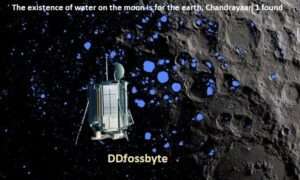In a remarkable discovery, Chandrayaan-1 has unveiled the profound connection between Earth and the moon, shedding light on how our planet played a pivotal role in providing water to our lunar neighbor.

Here we delves into the groundbreaking findings that highlight the intriguing relationship between Earth and the moon’s water.
Revealing the Lunar Mystery
Chandrayaan-1, India’s lunar probe, has been instrumental in unraveling the mystery of water on the moon’s surface. While the presence of water molecules on the moon has been a subject of scientific interest for years, the source of this water remained shrouded in uncertainty until now.
The Earth’s Precious Contribution
Recent research conducted by Chandrayaan-1 has provided compelling evidence that a significant portion of the moon’s water, particularly in the form of hydroxyl (OH) and water (H2O) molecules, originates from our own planet, Earth. This revelation challenges previous theories that suggested other sources for lunar water.

Understanding the Process
The process by which Earth contributed water to the moon is intriguing. It is believed that comets and meteorites, carrying water-rich compounds, bombarded both Earth and the moon in their early history. While Earth’s gravity retained and facilitated the distribution of water molecules, the moon’s weaker gravity caused them to accumulate on its surface.
Impact on Lunar Exploration
The discovery of Earth’s contribution to the moon’s water has significant implications for future lunar exploration missions. Water is a precious resource in space exploration, as it can be converted into oxygen for breathing and hydrogen for rocket fuel. Therefore, the presence of accessible water on the moon could potentially simplify and enhance future lunar missions.
Scientific Collaboration
Chandrayaan-1’s findings have underlined the importance of international collaboration in space exploration. Scientists and researchers from around the world have joined forces to analyze the data collected by this lunar probe, showcasing the global effort to unlock the secrets of our celestial neighbors.

Researchers from the University of Hawaii in Manoa, USA, have put forth a fascinating theory:
Chandrayaan 1, which embarked on its journey on October 22, 2008, and intentionally crashed onto the lunar surface on November 14 of the same year, played a pivotal role in uncovering the presence of water on the Moon. The deliberate crash landing was a strategic move to collect valuable data about our celestial neighbor. The data from Chandrayaan 1 not only confirmed the existence of lunar water but also hinted at Earth’s role in this lunar phenomenon.

India’s Chandrayaan-1 lunar mission made a surprising discovery in 2008: the presence of water ice on the Moon. Earth may have played a role in helping the Moon get its water.
Some of these charged particles are hydrogen ions. When the Moon passes through the magnetosphere, some of these hydrogen ions are captured by the Moon’s magnetic field and deposited on its surface.
Earth may have played a role in helping the Moon get its water. This is because the Moon’s magnetic field is weaker than Earth’s magnetic field. This means that more hydrogen ions from Earth are able to reach the Moon’s surface and form water ice.

Chandrayaan-1’s groundbreaking discovery regarding the origin of water on the moon has deepened our understanding of the interconnectedness of celestial bodies in our solar system. The revelation that Earth played a pivotal role in gifting water to the moon opens up exciting possibilities for future lunar exploration and underscores the importance of continued scientific investigation in unraveling the mysteries of our universe. As Chandrayaan-1 continues to provide valuable insights, it reaffirms India’s commitment to advancing our knowledge of space and its wonders.
